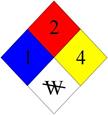
What Is NFPA 704?
Whether you're with the fire department, emergency medical services, or are a member of a hazmat team, at some point on the job, you're going to deal with the National Fire Protection Association's 704 – the Standard System for the Identification of the Hazards of Materials for Emergency Response.
"NFPA 704 is an essential part of our response to a facility. There is no way that any fire department can have intimate knowledge of every building, so having as much information about one when we respond is vital to an incident commander," explained Dave Nemeyer, Fire and Life Safety Division chief with Forest Grove, Ore., Fire & Rescue. "Adequate and correct NFPA 704 signage are just one component, but when you combine that with a good pre-fire plan of the building, it's almost as good as it can get for us."
For emergency responders, it's critical to know right away the color and number within the NFPA Diamond in order to quickly identify the hazard. As far as the NFPA 704 signage colors -- blue (health), red (fire), yellow (instability), and white (blank) sections -- the key to remember is that the diamonds must be viewable from a distance to maintain compliance.
For a sign designed to be viewable from 50 feet, for example, the overall placard (four-diamond region) must be a minimum of 2.5 inches wide, with each individual hazard diamond no smaller than 1.25 inches wide. The individual hazard rating numbers have to be 1 inch high, and the character's spine is even regulated to be no less than 0.16 inches at that distance, severely restricting font options. Signs should be prominently displayed so that emergency responders will see them from arrival locations.
Emergency crews can then determine the procedures, precautions, and which types of special equipment are best suited for the situation. For hazardous materials teams, the NFPA 704 placard is the initial building block of an emergency response plan. "There are times that the initial call may be a complaint that only gets an EMS response, like shortness of breath, that the 704 could serve as a clue if the responding crew sees it," said Jim Williams, EMS Field Operations manager for Medical Center EMS in Bowling Green, Ky. "Also, a visible 704 may have the effect of making a responder more cautious, especially if it is at a location a firefighter doesn't typically associate with chemicals, like an office building."
Fortunately, there are thousands of community colleges across the country offering paramedic education covering immediate care, stabilizing sick or injured people, transport to medical facilities, assessing emergency scenes, controlling bleeding, applying splints, administering oxygen, and CPR. But what happens when it's "showtime" is different for everyone. Likely there is a lot of on-the-job education, too. Either way, it can only help to study and recognize NFPA standards.
There's a great quote that sums up the importance of proper NFPA 704 and other emergency responder signage from Academic Surgeon Samuel Gross, 1807-1884:
"Hesitance ... must yield to decision; tardiness to promptness; timidity to boldness. The patient is saved or lost in a moment."
Jack Rubinger handles Public Relations for Graphic Products, Inc. of Beaverton, Ore.
Posted by Jack Rubinger on Jul 15, 2013